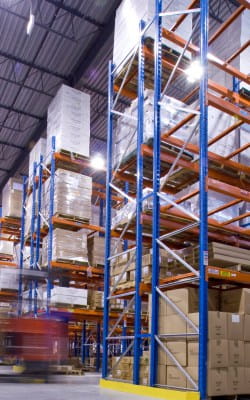Steel Storage Racks
YOUR STORAGE RACKS
Failure is not an option
By: John Ferrari, P.Eng., P.M.M.
Steel Storage Racks are the backbone of every warehouse. The number of large, public warehouses has increased significantly over the past few decades. Yet, despite their prevalence, after their initial installation many of us don’t give much thought to rack maintenance.
Improper selection of rack types, poor installation, overloading, unauthorized
modifications and damage from forklift equipment are serious safety concerns.
Reduce the risk of costly losses by training your staff to be knowledgeable and proficient in the areas of inspecting and maintaining racks. One significant change to the new edition of CSA A344, ‘User Guide for Steel Storage Racks’, is an expanded section on the inspection and maintenance of racks, with new content specific to damage and deficiency identification and classification. Rack users can now reference this valuable resource for best practices on recognizing general rack hazards, identifying key inspection areas and prioritizing deficiencies.
Inspections
Keeping your warehouse operating safely and at peak efficiency starts with regularly
scheduled inspections. A comprehensive rack inspection should make note of any variance from drawings of the system’s installation, of pallets and loads being stored, the condition of the rack, modifications to the structure, use of the system, and the surrounding work environment.
The inspection program itself should include routine inspections, typically monthly by competent persons who have knowledge of potential or actual dangers to workplace safety; and more rigorous expert inspections, typically annually. Engineers with special knowledge and
training in structural engineering concepts and rack inspection procedures often conduct these. Always ensure racks are inspected by an expert immediately after a forklift collision or a seismic event.
Maintenance
Pallet rack failures are generally a result of misuse, such as forklift impact or overloading. Canadian legislation imposes a legal duty on all those who direct work, including employers, to take reasonable measures to protect employee and public safety. Employers, owners, and lessees are responsible for ensuring racks are configured, maintained, and used in accordance with the documentation provided by the rack manufacturer.
Even with vigilant personnel, it’s not a question of “if” but “when” your rack will
sustain a collision from forklift equipment.
In a high-throughput facility racks are often subject to abuse, while component wear and tear goes unnoticed. Cumulative damage from continued forklift strikes cannot be neglected and may ultimately trigger a collapse of the storage structure.
The extent and type of damage is critical in determining whether repair or replacement of a component is warranted. If damage is found, remediation should take place as soon as possible to mitigate risks. A rack collapse has dire consequences: serious injury or fatality, damage to merchandise and property, disruption to business operations, increased insurance premiums, and
fines with possible prosecution.
Compliance
Conducting inspections alone is not enough. Maintaining proper documentation that is readily available in the workplace for review by the Joint Health and Safety Committee or by regulatory health and safety inspectors is critical. Each damaged or deficient item noted during the inspection should be documented and categorized using the limits established by the expert inspection. When a component is categorized, it should be clearly identified as such by marking or tagging.
The tracking of the inspection process – scheduling, site observations and photos with location data on layout drawings, assessments, remedial actions and recommendations – should all be retained on file. The posting of permanent capacity plaques in one or more visible locations
is also required for all rack installations so that employees are mindful of the structures load limitations. Always be prepared to demonstrate due diligence by ensuring your storage structure is in compliance with current applicable standards.
Safety is King
When it comes to warehouse safety, you can’t afford to cut corners. If you have any indication that the integrity of your rack system is compromised, address it immediately. Rack structures are generally not engineered with allowances that account for loss of capacity due to damage.
Emphasize rigorous forklift operator training and always encourage employees to promptly report all incidents. Safety is everyone’s responsibility.
If you have any concerns, consult with a qualified firm with proven expertise in the design, installation and maintenance of these structures. Ideally, your rack manufacturer or supplier should offer aftersales services that will evaluate your needs and recommend design and maintenance solutions that are tailored to your facility’s specific requirements.
Safety is no accident; it’s a choice you make. Give your storage racks the attention they need because failure is not an option.

